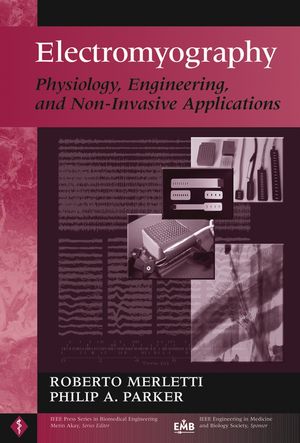Electromyography: Physiology, Engineering, and Non-Invasive ApplicationsISBN: 978-0-471-67580-8
Hardcover
520 pages
July 2004, Wiley-IEEE Press
 This is a Print-on-Demand title. It will be printed specifically to fill your order. Please allow an additional 10-15 days delivery time. The book is not returnable.
|
||||||
Contributors.
1 BASIC PHYSIOLOGY AND BIOPHYSICS OF EMG SIGNAL GENERATION (T. Moritani, D. Stegeman, R. Merletti).
1.1 Introduction.
1.2 Basic Physiology of Motor Control and Muscle Contraction.
1.3 Basic Electrophysiology of the Muscle Cell Membrane.
References.
2 NEEDLE AND WIRE DETECTION TECHNIQUES (J. V. Trontelj, J. Jabre, M. Mihelin).
2.1 Anatomical and Physiological Background of Intramuscular Recording.
2.2 Recording Characteristics of Needle Electrodes.
2.3 Conventional Needle EMG.
2.4 Special Needle Recording Techniques.
2.5 Physical Characteristics of Needle EMG Signals.
2.6 Recording Equipment.
References.
3 DECOMPOSITION OF INTRAMUSCULAR EMG SIGNALS (D. W. Stashuk, D. Farina, K. Søgaard).
3.1 Introduction.
3.2 Basic Steps for EMG Signal Decomposition.
3.3 Evaluation of Performance of EMG Signal Decomposition Algorithms.
3.4 Applications of Results of the Decomposition of an Intramuscular EMG Signal.
3.5 Conclusions.
References.
4 BIOPHYSICS OF THE GENERATION OF EMG SIGNALS (D. Farina, R. Merletti, D. F. Stegeman).
4.1 Introduction.
4.2 EMG Signal Generation.
4.3 Crosstalk.
4.4 Relationships between Surface EMG Features and Developed Force.
4.5 Conclusions.
References.
5 DETECTION AND CONDITIONING OF THE SURFACE EMG SIGNAL (R. Merletti, H. Hermens).
5.1 Introduction.
5.2 Electrodes: Their Transfer Function.
5.3 Electrodes: Their Impedance, Noise, and dc Voltages.
5.4 Electrode Configuration, Distance, Location.
5.5 EMG Front-End Amplifiers.
5.6 EMG Filters: Specifications.
5.7 Sampling and A/D Conversion.
5.8 European Recommendations on Electrodes and Electrode Locations.
References.
6 SINGLE-CHANNEL TECHNIQUES FOR INFORMATION EXTRACTION FROM THE SURFACE EMG SIGNAL (E. A. Clancy, D. Farina, G. Filligoi).
6.1 Introduction.
6.2 Spectral Estimation of Deterministic Signals and Stochastic Processes.
6.3 Basic Surface EMG Signal Models.
6.4 Surface EMG Amplitude Estimation.
6.5 Extraction of Information in Frequency Domain from Surface EMG Signals.
6.6 Joint Analysis of EMG Spectrum and Amplitude (JASA).
6.7 Recurrence Quantification Analysis of Surface EMG Signals.
6.8 Conclusions.
References.
7 MULTI-CHANNEL TECHNIQUES FOR INFORMATION EXTRACTION FROM THE SURFACE EMG (D. Farina, R. Merletti, C. Disselhorst-Klug).
7.1 Introduction.
7.2 Spatial Filtering.
7.3 Spatial Sampling.
7.4 Estimation of Muscle-Fiber Conduction Velocity.
7.5 Conclusions.
References.
8 EMG MODELING AND SIMULATION (D. F. Stegeman, R. Merletti, H. J. Hermens).
8.1 Introduction.
8.2 Phenomenological Models of EMG.
8.3 Elements of Structure-Based SEMG Models.
8.4 Basic Assumptions.
8.5 Elementary Sources of Bioelectric Muscle Activity.
8.6 Fiber Membrane Activity Profiles, Their Generation, Propagation, and Extinction.
8.7 Structure of the Motor Unit.
8.8 Volume Conduction.
8.9 Modeling EMG Detection Systems.
8.10 Modeling Motor Unit Recruitment and Firing Behavior.
8.11 Inverse Modeling.
8.12 Modeling of Muscle Fatigue.
8.13 Other Applications of Modeling.
8.14 Conclusions.
References.
9 MYOELECTRIC MANIFESTATIONS OF MUSCLE FATIGUE (R. Merletti, A. Rainoldi, D. Farina).
9.1 Introduction.
9.2 Definitions and Sites of Neuromuscular Fatigue.
9.3 Assessment of Muscle Fatigue.
9.4 How Fatigue Is Reflected in Surface EMG Variables.
9.5 Myoelectric Manifestations of Muscle Fatigue in Isometric Voluntary Contractions.
9.6 Fiber Typing and Myoelectric Manifestations of Muscle Fatigue.
9.7 Factors Affecting Surface EMG Variable.
9.8 Repeatability of Estimates of EMG Variables and Fatigue Indexes.
9.9 Conclusions.
References.
10 ADVANCED SIGNAL PROCESSING TECHNIQUES (D. Zazula, S. Karlsson, C. Doncarli).
10.1 Introduction.
10.2 Theoretical Background.
10.3 Decomposition of EMG Signals.
10.4 Applications to Monitoring Myoelectric Manifestations of Muscle Fatigue.
10.5 Conclusions.
Acknowledgment.
References.
11 SURFACE MECHANOMYOGRAM (C. Orizio).
11.1 The Mechanomyogram (MMG): General Aspects during Stimulated and Voluntary Contraction.
11.2 Detection Techniques and Sensors Comparison.
11.3 Comparison between Different Detectors.
11.4 Simulation.
11.5 MMG Versus Force: Joint and Adjunct Information Content.
11.6 MMG Versus EMG: Joint and Adjunct Information Content.
11.7 Area of Application.
References.
12 SURFACE EMG APPLICATIONS IN NEUROLOGY (M. J. Zwarts, D. F. Stegeman, J. G. van Dijk).
12.1 Introduction.
12.2 Central Nervous System Disorders and SEMG.
12.3 Compound Muscle Action Potential and Motor Nerve Conduction.
12.4 CMAP Generation.
12.5 Clinical Applications.
12.6 Pathological Fatigue.
12.7 New Avenues: High-Density Multichannel Recording.
12.8 Conclusion.
References.
13 APPLICATIONS IN ERGONOMICS (G. M. Hägg, B. Melin, R. Kadefors).
13.1 Historic Perspective.
13.2 Basic Workload Concepts in Ergonomics.
13.3 Basic Surface EMG Signal Processing.
13.4 Load Estimation and SEMG Normalization and Calibration.
13.5 Amplitude Data Reduction over Time.
13.6 Electromyographic Signal Alterations Indicating Muscle Fatigue in Ergonomics.
13.7 SEMG Biofeedback in Ergonomics.
13.8 Surface EMG and Musculoskeletal Disorders.
13.9 Psychological Effects on EMG.
References.
14 APPLICATIONS IN EXERCISE PHYSIOLOGY (F. Felici).
14.1 Introduction.
14.2 A Few “Tips and Tricks”.
14.3 Time and Frequency Domain Analysis of sEMG: What Are We Looking For?
14.4 Application of sEMG to the Study of Exercise.
14.5 Strength and Power Training.
14.6 Muscle Damage Studied by Means of sEMG.
References.
15 APPLICATIONS IN MOVEMENT AND GAIT ANALYSIS (C. Frigo, R. Shiavi).
15.1 Relevance of Electromyography in Kinesiology.
15.2 Typical Acquisition Settings.
15.3 Study of Motor Control Strategies.
15.4 Investigation on the Mechanical Effect of Muscle Contraction.
15.5 Gait Analysis.
15.6 Identification of Pathophysiologic Factors.
15.7 Workload Assessment in Occupational Biomechanics.
15.8 Biofeedback.
15.9 The Linear Envelope.
15.10 Information Enhancement through Multifactorial Analysis.
References.
16 APPLICATIONS IN REHABILITATION MEDICINE AND RELATED FIELDS (A. Rainoldi, R. Casale, P. Hodges, G. Jull).
16.1 Introduction.
16.2 Electromyography as a Tool in Back and Neck Pain.
16.3 EMG of the Pelvic Floor: A New Challenge in Neurological Rehabilitation.
16.4 Age-Related Effects on EMG Assessment of Muscle Physiology.
16.5 Surface EMG and Hypobaric Hipoxia.
16.6 Microgravity Effects on Neuromuscular System.
References.
17 BIOFEEDBACK APPLICATIONS (J. R. Cram).
17.1 Introduction.
17.2 Biofeedback Application to Impairment Syndromes.
17.3 SEMG Biofeedback Techniques.
17.4 Summary.
References.
18 CONTROL OF POWERED UPPER LIMB PROSTHESES (P. A. Parker, K. B. Englehart, B. S. Hudgins).
18.1 Introduction.
18.2 Myoelectric Signal as a Control Input.
18.3 Conventional Myoelectric Control.
18.4 Emerging MEC Strategies.
18.5 Summary.
References.
Index.



